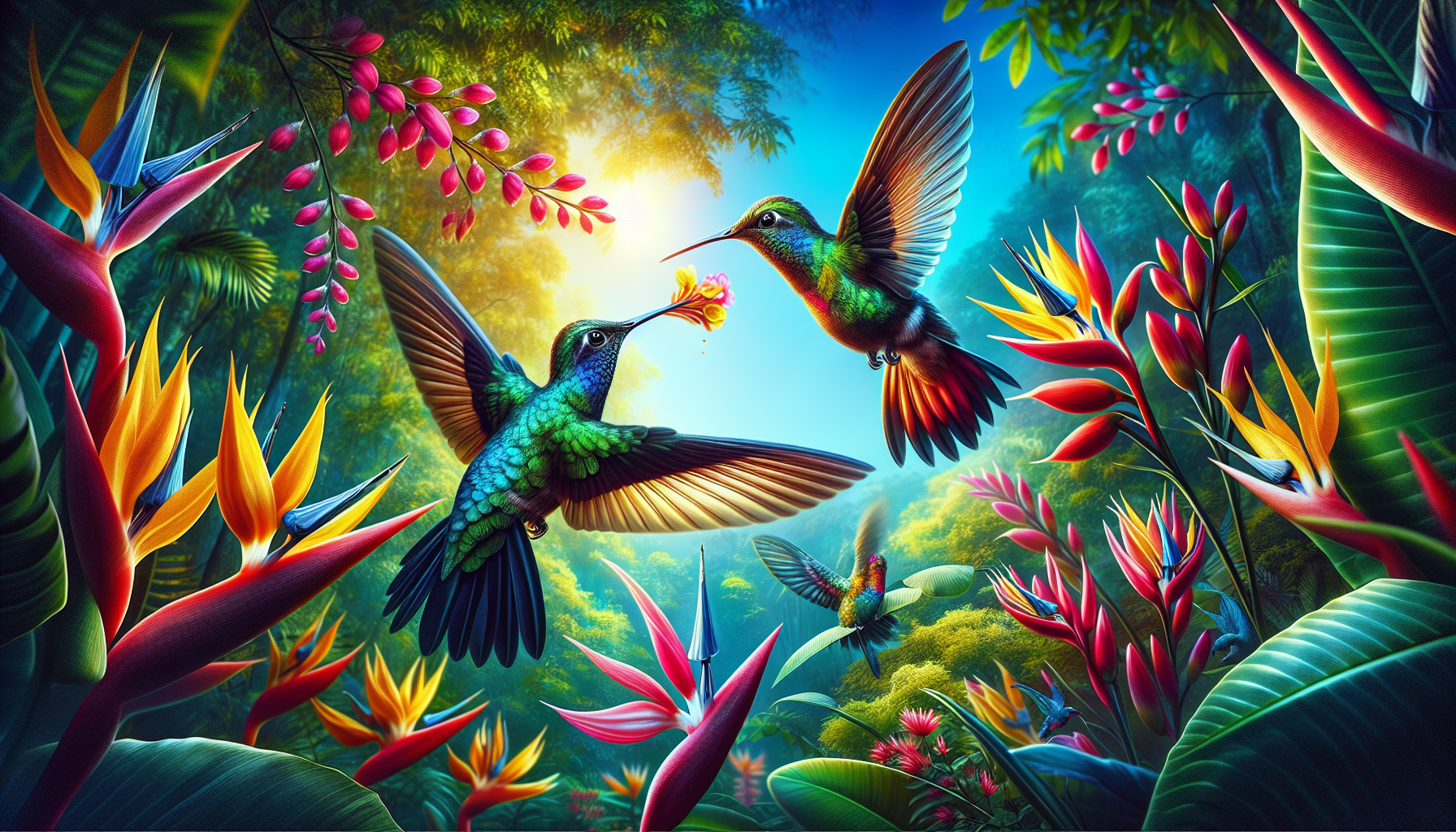Have you ever marveled at the beauty and grace of hummingbirds as they flit and hover in mid-air, their vibrant feathers glinting in the sunlight? These tiny creatures, often referred to as nature’s tiny jewels, are a true wonder of the animal kingdom. In this article, we will delve into the secrets behind their dazzling dance, exploring their incredible agility, unique characteristics, and the remarkable adaptations that allow them to perform their aerial acrobatics with such finesse. Get ready to be captivated by the enchanting world of hummingbirds!

The Evolution and Anatomy of Hummingbirds
Origins of Hummingbirds
Hummingbirds are a unique group of birds that belong to the family Trochilidae. They are native to the Americas, with the majority of species found in Central and South America. These remarkable creatures have a long evolutionary history that dates back millions of years. Fossil evidence suggests that hummingbirds have existed for at least 30 million years, making them one of the oldest bird families in the world.
Physical Characteristics of Hummingbirds
Hummingbirds are known for their small size, with most species measuring between 3 and 5 inches in length. Despite their tiny stature, they are incredibly lightweight, weighing only a few grams. One of the most distinctive features of hummingbirds is their long, slender beak, which is perfectly adapted for feeding on nectar. Their wings are also unique, having the ability to rotate in a full circle, allowing them to hover in mid-air and fly in any direction. Additionally, hummingbirds have brilliant plumage, often displaying vibrant colors such as red, green, and blue.
Unique Features of Hummingbird Anatomy
The anatomy of hummingbirds is truly fascinating. In addition to their specialized beaks and wings, they have several other unique features. Their hearts, for example, are incredibly efficient, beating up to 1,200 times per minute. This high heart rate is necessary to support their rapid wing movements, which can reach an astonishing 80 beats per second. Another interesting aspect of hummingbird anatomy is their ability to enter a state of torpor during periods of low energy. This allows them to conserve energy by lowering their metabolic rate and body temperature.
The Fascinating Flight of Hummingbirds
Hovering Abilities of Hummingbirds
One of the most captivating aspects of hummingbirds is their ability to hover in mid-air. Unlike most birds that require forward momentum to remain airborne, hummingbirds can hold their position by rapidly flapping their wings and counteracting gravity. This unique hovering ability is made possible by the specific anatomy of their wings, which allows them to generate lift in both the upstroke and downstroke. By rotating their wings in a figure-eight motion, hummingbirds create enough lift to remain stationary in the air, making them the only birds capable of sustained hovering.
Speed and Agility in Flight
Hummingbirds are not only masters of hovering, but they are also incredibly agile and swift in flight. They can reach speeds of up to 60 miles per hour during their migratory journeys, making them one of the fastest birds in the world. Their ability to change direction quickly and navigate complex flight paths is attributed to their unique wing structure and flexibility. The rapid wing movements of hummingbirds enable them to make sharp turns, hover in tight spaces, and even fly upside down.
The Physics Behind Hummingbird Flight
The flight capabilities of hummingbirds can be attributed to the principles of physics. Their rapid wing flapping generates lift, similar to how an airplane wing creates lift by manipulating air pressure. Additionally, the unique figure-eight motion of their wings creates a vortex behind them, allowing hummingbirds to maintain stability and maneuverability. Their small size also plays a role in their flight abilities, as smaller birds experience less drag than larger ones. These physical adaptations enable hummingbirds to perform their remarkable aerial feats.
A Glimpse into Hummingbird Behavior
Feeding Habits of Hummingbirds
Hummingbirds mainly feed on the nectar of flowers, earning them the nickname “nature’s little pollinators.” Their long beaks and tongues are perfectly designed for extracting nectar from deep within flowers. While nectar provides them with the majority of their energy, hummingbirds also consume small insects and spiders to supplement their diet with protein. To maintain their high metabolism, they must consume several times their body weight in nectar and insects every day.
Hummingbird Nests and Reproduction
Hummingbirds build their nests using various materials such as moss, lichen, and spider silk. The nests are often small and cup-shaped, providing a safe haven for their delicate eggs. Female hummingbirds take on the responsibility of incubating the eggs, typically laying two white, pea-sized eggs. The incubation period lasts around 14 to 23 days, depending on the species. Once hatched, the chicks are fed a diet of regurgitated nectar and insects until they are ready to fledge.
Territorial Behavior of Hummingbirds
Hummingbirds are highly territorial birds and fiercely defend their feeding and nesting areas. They will engage in aggressive displays, such as aerial battles and chasing one another, to establish dominance. The males of some species even perform elaborate courtship displays to attract females. These displays involve a combination of flying patterns, vocalizations, and aerial acrobatics. In some cases, the males’ vibrant plumage plays a crucial role in attracting a mate and asserting dominance over rivals.

The Colorful World of Hummingbird Plumage
Vibrant Feather Colors
Hummingbirds are renowned for their vibrant plumage, which displays a wide range of colors. These colors are not produced by pigments but are rather the result of structural modifications in their feathers. The microscopic structure of their feathers refracts and reflects light, creating intense hues that seem to change depending on the angle of view. From the bold reds of the ruby-throated hummingbird to the shimmering greens of the emerald hummingbird, the colors of these tiny birds never fail to captivate.
Iridescence and Shimmering Effects
One of the most intriguing aspects of hummingbird plumage is the phenomenon of iridescence. Iridescence occurs when the colors of an object appear to change as the viewing angle changes. The iridescent feathers of hummingbirds are a result of the microscopic structures on the surface of their feathers, which reflect and refract light in different ways. This gives them the appearance of glowing or shimmering in various shades, adding to their ethereal beauty.
The Role of Plumage in Mating and Display
The colorful plumage of hummingbirds plays a vital role in their mating and territorial displays. Males use their vibrant feathers as a visual signal to attract females and establish dominance over rival males. The intensity and brilliance of their plumage often correlate with the social status and reproductive success of the males. Females, on the other hand, may use subtle coloration to camouflage themselves during nesting or to blend in with specific flowers, aiding in their foraging and survival.
Hummingbird Migration Patterns
Global Range of Hummingbird Species
Hummingbirds are primarily found in the Americas, from Alaska to Tierra del Fuego. They have a diverse distribution, with over 330 known species. Some species are endemic to specific regions, while others have wide-ranging distributions. The greatest species diversity can be found in regions such as the Andes Mountains and the cloud forests of Central America.
Long-distance and Short-distance Migrants
Not all hummingbird species migrate, but many undertake long and arduous journeys in search of more favorable habitats and food sources. Some species travel thousands of miles each year, crossing vast stretches of land and even water. These long-distance migrations require immense energy and endurance, as hummingbirds must continuously feed to fuel their demanding flights. In contrast, other species are considered short-distance migrants, moving only a few hundred miles from their breeding grounds in search of suitable wintering areas.
Impressive Navigation Abilities
Hummingbirds possess remarkable navigation abilities that allow them to navigate complex migratory routes. They rely on a combination of innate instincts and environmental cues to guide their journeys. The position of the sun, magnetic fields, landmarks, and even the scent of flowers are utilized by these tiny birds to navigate with precision. Their ability to remember and return to specific feeding and nesting sites further emphasizes their incredible navigational skills.
Hummingbird Feeding and Nectar Plants
Preferred Nectar Sources
Hummingbirds rely heavily on nectar as their primary source of energy. While they are known to feed on the nectar of various flowers, they have certain preferences when it comes to nectar sources. Tubular-shaped flowers that are brightly colored and have a high sugar content are highly attractive to hummingbirds. Some popular nectar plants for hummingbirds include trumpet vine, bee balm, salvia, and butterfly bush. By planting these nectar-rich flowers, you can create a haven for hummingbirds in your own backyard.
Hummingbird Feeders and Sugar Water
To supplement natural nectar sources, many people set up hummingbird feeders in their gardens. These feeders provide a readily available source of sugar water for hummingbirds to fuel their high-energy lifestyles. It is important to prepare the sugar water solution correctly, using a ratio of four parts water to one part granulated sugar. Red coloring or artificial sweeteners should never be added to the solution, as they can be harmful to the birds. Regular cleaning and maintenance of feeders are essential to prevent bacterial growth and ensure the health of the hummingbirds.
Attracting Hummingbirds to Your Garden
Creating a hummingbird-friendly garden involves more than just providing nectar sources. Hummingbirds also require suitable perching spots, shelter, and access to water. Planting shrubs and trees that provide perches and nesting materials, providing sources of moving water such as misters or birdbaths, and reducing the use of pesticides can all contribute to creating a welcoming habitat for hummingbirds. Additionally, strategic positioning of feeders and flowers can help attract these enchanting birds to your garden.
Threats and Conservation Efforts for Hummingbirds
Habitat Loss and Fragmentation
Like many other species, hummingbirds face significant threats due to habitat loss and fragmentation. Deforestation, urban development, and agricultural expansion have resulted in the destruction of vital habitats for these birds. This loss of habitat not only reduces the availability of suitable nesting and foraging sites but also disrupts migratory corridors, making it more challenging for hummingbirds to complete their journeys. Protecting and restoring their habitats is crucial for the long-term survival of hummingbird populations.
Effects of Climate Change
Climate change poses a serious threat to hummingbirds and their habitats. Rising temperatures and shifting weather patterns can disrupt the timing of flower bloom and affect the availability of nectar sources. Changes in precipitation patterns can also impact the abundance of flowering plants. As hummingbirds rely on accurate timing to coincide their migrations and breeding cycles with peak nectar availability, any disruptions in these synchronizations can have significant consequences for their survival. Efforts to mitigate climate change and protect their habitats are essential for the conservation of hummingbirds.
Conservation Initiatives and Research
Numerous organizations and researchers around the world are actively engaged in efforts to conserve hummingbird populations. These initiatives focus on habitat restoration, education, and research to better understand the needs and behaviors of hummingbirds. By raising awareness about the importance of these fascinating birds, supporting conservation efforts, and participating in citizen science projects, individuals can contribute to the conservation of hummingbirds and their fragile ecosystems.
Hummingbird Species and Diversity
The Many Different Hummingbird Species
The world of hummingbirds is incredibly diverse, with over 330 recognized species. These species vary greatly in size, coloration, range, and behavior. Some of the most well-known hummingbird species include the ruby-throated hummingbird, Anna’s hummingbird, and the magnificent hummingbird. Each species possesses its own unique characteristics and adaptations, making them highly specialized for survival in their specific habitats.
Endemic Species and Hotspots
Certain regions of the Americas are known as hummingbird hotspots, boasting a high concentration of unique species. The cloud forests of the Andes, for example, are home to a remarkable array of endemic hummingbirds. These endemic species can be found nowhere else in the world and are highly adapted to the specific conditions of their habitats. Protecting these hotspots and preserving the unique biodiversity they harbor is crucial for the survival of hummingbird species.
Unique Adaptations of Some Hummingbirds
While all hummingbirds share common characteristics, some species possess unique adaptations that set them apart. For example, the sword-billed hummingbird has an exceptionally long bill that allows it to feed on flowers with long corollas. The black-bellied hummingbird has evolved specialized feathers that produce whirring sounds during courtship displays. These adaptations highlight the incredible diversity and specialization that exists within the hummingbird family.
The Fascination with Hummingbirds in Folklore and Mythology
Cultural Significance of Hummingbirds
Hummingbirds hold a special place in the folklore and mythology of various cultures throughout the Americas. In indigenous cultures, they are often seen as symbols of joy, love, and endurance. Some Native American tribes believe that hummingbirds bring good luck and prosperity. In Central and South America, hummingbirds are associated with fertility, transformation, and spiritual insight. Their beauty, grace, and seemingly magical abilities have inspired countless legends and stories in different cultures.
Symbolism and Meanings in Different Cultures
Hummingbirds are attributed with various symbolic meanings across different cultures. In some traditions, they are seen as messengers between the human world and the spirit world. Their rapid wing movements and ability to hover have made them symbols of agility and adaptability. In Native American folklore, seeing a hummingbird is believed to bring happiness and good fortune. The significance and symbolism associated with hummingbirds reflect the deep admiration and reverence these birds inspire.
Hummingbirds as Spiritual and Totem Animals
For many individuals, hummingbirds hold deep spiritual significance. They are often considered to be spirit animals, representing qualities such as resilience, playfulness, and appreciation of the present moment. The belief in hummingbird totems extends across different spiritual practices, including Native American spirituality and shamanism. By connecting with the energy and symbolism of hummingbirds, individuals seek to tap into their innate qualities and find guidance and inspiration in their own lives.
Photographing Hummingbirds: Tips and Techniques
Choosing the Right Equipment
Photographing hummingbirds can be a challenging yet rewarding experience. To capture these fast-moving birds, it is important to have the right equipment. A camera with a high continuous shooting speed and a long telephoto lens will allow you to capture the intricate details of hummingbirds in flight. Additionally, a sturdy tripod or monopod will help stabilize your shots. Patience and practice are key when it comes to photographing these elusive creatures.
Setting up Attractive Feeding Stations
To increase your chances of photographing hummingbirds, you can set up attractive feeding stations in your garden. Opt for brightly colored feeders and strategically position them near perching spots and flowers. Placing the feeders in a quiet and secluded area will help minimize disturbances and attract more hummingbirds. Remember to keep the feeders clean and filled with fresh sugar water to ensure the health and well-being of the birds.
Techniques for Capturing the Perfect Shot
When photographing hummingbirds, it is essential to experiment with different techniques to capture the perfect shot. Using a fast shutter speed will freeze the motion of the bird’s wings, allowing you to capture their intricate details. Continuous autofocus and burst mode will help you track the hummingbird’s movements and capture multiple shots. It is also important to pay attention to lighting conditions and background elements to create visually appealing compositions. By employing these techniques and honing your photography skills, you can capture the beauty and grace of hummingbirds in stunning detail.
In conclusion, hummingbirds are truly nature’s tiny jewels, captivating us with their unique flight abilities, vibrant plumage, and fascinating behaviors. Through understanding their evolutionary history, appreciating their delicate anatomy, and learning about their diverse species and behaviors, we can better appreciate and protect these enchanting creatures. Whether we encounter them in our own gardens or in the wild, the magical world of hummingbirds is waiting to be unraveled and admired.

My name is Shane Warren, the author behind Your Bird Buddy – your ultimate guide to the wonderful world of birds! Unleash your inner avian explorer as we delve into a vibrant library of knowledge dedicated to all things feathered. From learning about diverse bird species from across the globe to understanding their captivating habitats and behaviors, I’m here to fuel your passion for these magnificent creatures. Not only that, but I also provide valuable insights on being a responsible and informed pet bird owner. Join our vibrant community and let’s celebrate the feathered wonders of the world together – one chirp at a time. And be sure to join our Your Bird Buddy Community over on Facebook!


Comments are closed